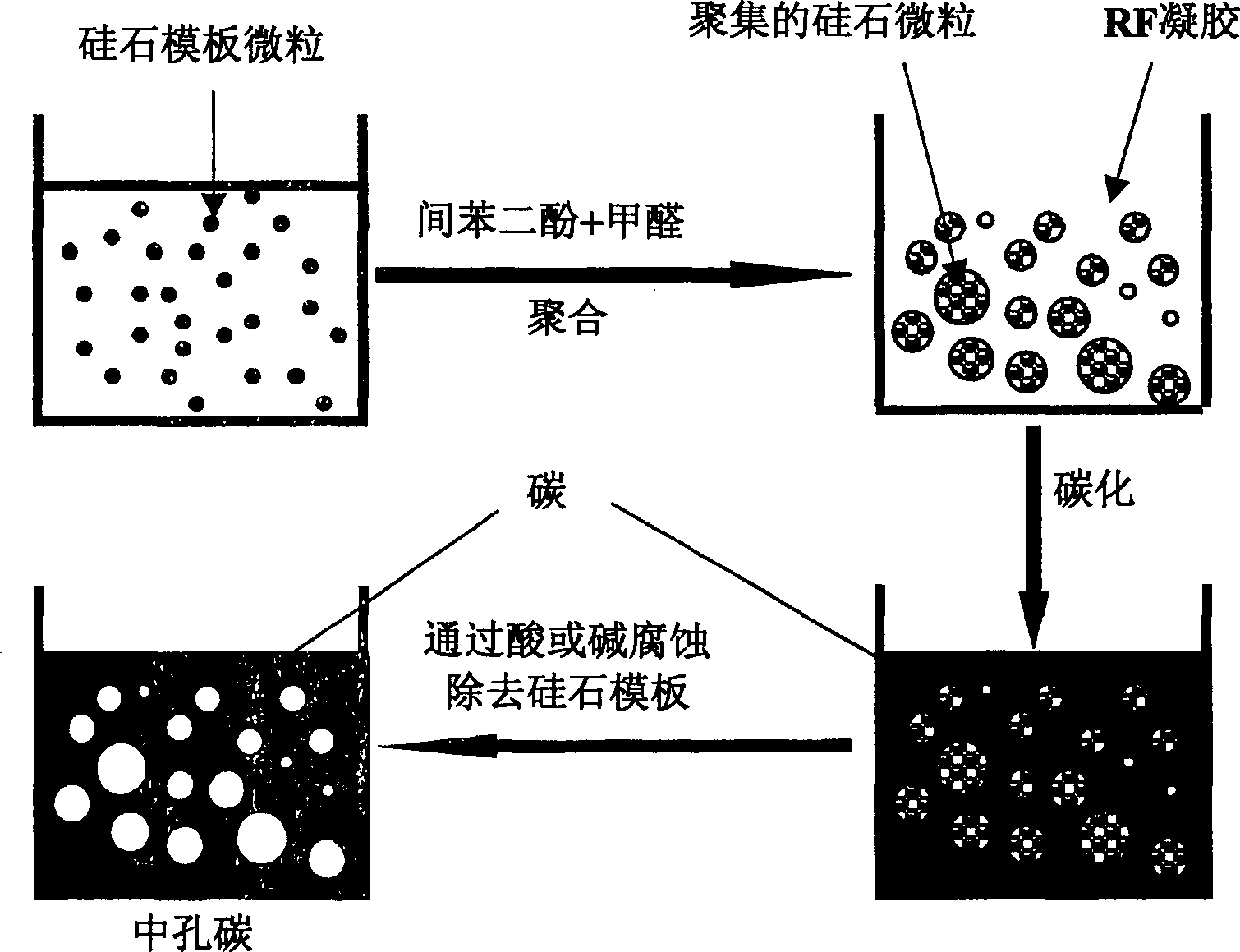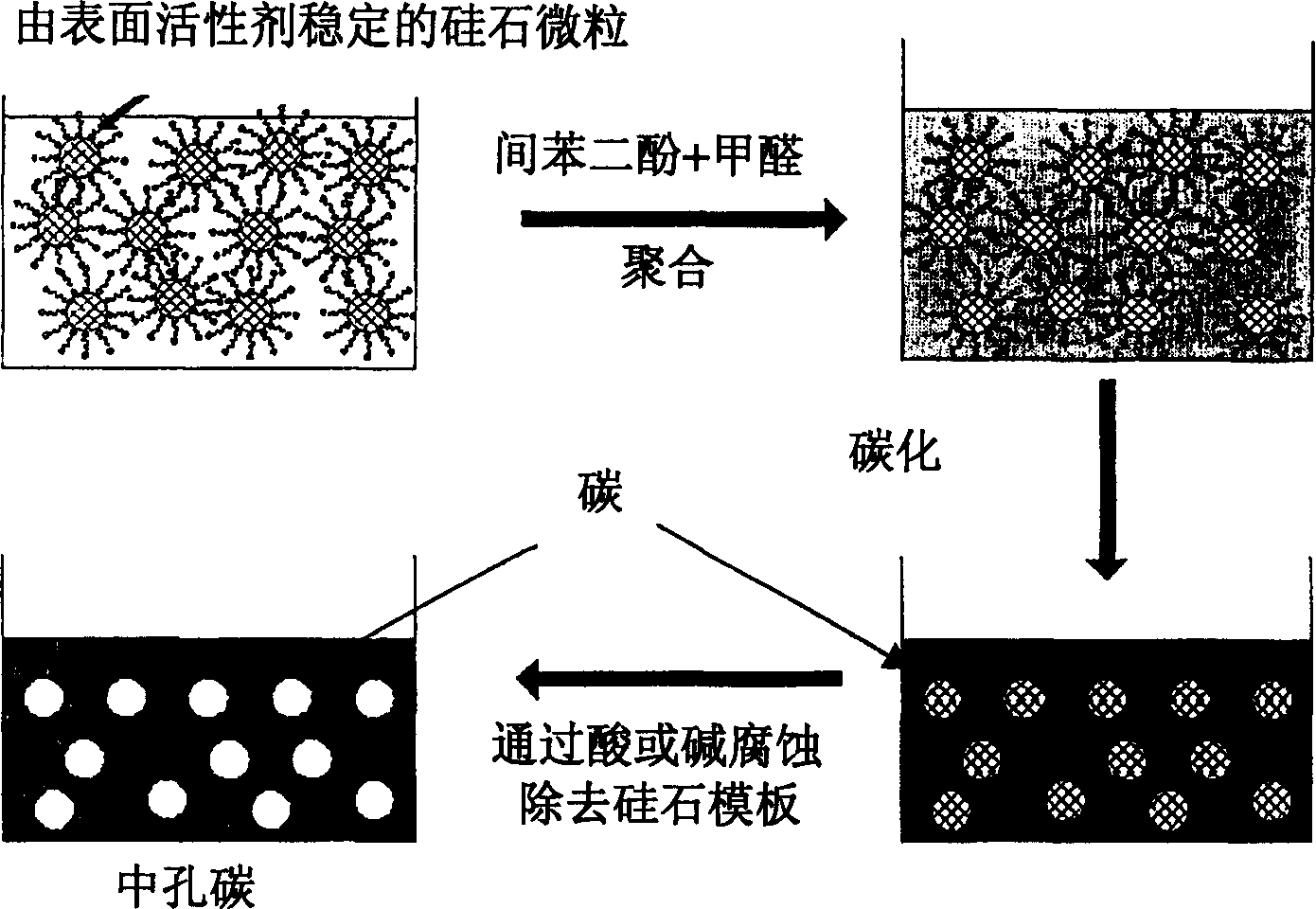Mesoporous carbon material, carbon/metal oxide composite materials, and electrochemical capacitors using them
A technology of composite materials and oxides, applied in the direction of electrolytic capacitors, hybrid capacitor electrodes, hybrid capacitor separators, etc., can solve the problems of limited commercialization, low conductivity, difficulty in using thick film forms and high current conditions, and achieve Improve the effect of unit capacitance
- Summary
- Abstract
- Description
- Claims
- Application Information
AI Technical Summary
Problems solved by technology
Method used
Image
Examples
Embodiment 1
[0079] A mixture of resorcinol and formaldehyde (molar ratio 1:2) was added to LUDOX SM-30 silica hydrogel to form a final molar ratio of 1:2:7.5:86 (resorcinol:formaldehyde:silica: water). The pH of the mixed solution was adjusted to 8 by adding 1N aqueous sodium hydroxide solution and 1N nitric acid aqueous solution. The mixed solution was concentrated and aged at 85° C. for 3 days to form a resorcinol-formaldehyde-gel / silica composite. Under a nitrogen atmosphere, the composite material was heated to 850° C. and transformed into a carbon / silica composite material, and the composite material was etched in 48% hydrofluoric acid for 12 hours while stirring to remove the silica and retain the mesoporous carbon. The synthesized mesoporous carbon has a specific surface area of 847 m2 / g and a pore volume of 2.6 cm3 / g. 99% of the pores are larger than 2 nm and the conductivity measured by Aida's method (Carbon, 24, 337 (1986)) is 7.2 S / cm. figure 1 A schematic procedure for E...
Embodiment 2
[0081] Mesoporous carbon was synthesized by the same method as in Example 1, except that LUDOX HS-40 was used instead of LUDOX SM-30. The synthesized mesoporous carbon has a specific surface area of 950 m2 / g, a pore volume of 5.5 cm3 / g and an average pore diameter of 23 nm. Furthermore, this carbon has 96% macroporosity (>2nm). figure 2 A SEM (scanning electron microscope) photograph of synthetic carbon at a magnification of 75,000 is shown. Such as figure 2 As shown, the pore size is between 10nm and 100nm.
Embodiment 3
[0083] Surfactant stabilized silica was prepared by adding 5 grams of cetyltrimethylammonium bromide to 100 ml of LUDOX SM-30 silica hydrosol. Residual surfactant was removed by washing 3-5 times with 100 ml of distilled water. Add dropwise a mixture of resorcinol, formaldehyde, sodium carbonate and water (1:2:0.015:5.6 in molar ratio) to the surfactant-stabilized silica sol solution until the silica is fully wetted, wherein sodium carbonate is used as the intermediate Catalyst for the formation of gels from quinone and formaldehyde. The mixture solution was aged at 85°C for 3 days to form a resorcinol-formaldehyde-gel / silica composite, which was heated at 850°C for 3 hours in nitrogen to transform the composite into a carbon / silica composite. The resulting composite was etched in 48% hydrofluoric acid for 12 hours with stirring to remove the silica in the composite to obtain the final mesoporous carbon. This carbon has a specific surface area of 1090 m2 / g, a pore volume o...
PUM
| Property | Measurement | Unit |
|---|---|---|
| pore size | aaaaa | aaaaa |
| diameter | aaaaa | aaaaa |
| size | aaaaa | aaaaa |
Abstract
Description
Claims
Application Information
 Login to View More
Login to View More - R&D
- Intellectual Property
- Life Sciences
- Materials
- Tech Scout
- Unparalleled Data Quality
- Higher Quality Content
- 60% Fewer Hallucinations
Browse by: Latest US Patents, China's latest patents, Technical Efficacy Thesaurus, Application Domain, Technology Topic, Popular Technical Reports.
© 2025 PatSnap. All rights reserved.Legal|Privacy policy|Modern Slavery Act Transparency Statement|Sitemap|About US| Contact US: help@patsnap.com



